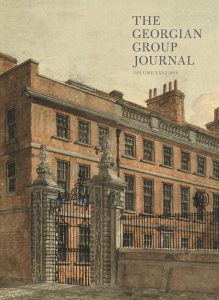| Author |
Article |
Pages |
| Anya Matthews |
“Costly without, richlier inlaid:” London’s post-fire Livery Halls |
1–20 |
| Charlotte Bassett |
A revised timeline for Sir William Bruce’s Hopetoun House, 1699–1707 |
21–40 |
| Frank Salmon |
The peer’s “smooth piers”: William Kent and Thomas Coke at work designing Holkham Hall in 1733–34 |
41–56 |
| Benjamin Riley |
“This little house of my invention:” Argyll House, Chelsea, and its first owner |
57–68 |
| Claire Hornsby |
Neo-classical display in the suburbs: investigating George Bubb Dodington’s patronage and taste |
69–86 |
| Gareth Williams |
Rome behind the battlements: James Byres at Sundorne, Shropshire |
87–102 |
| Richard Pears |
A Villa at the Coast: Newton Hall, Newton-by-the-Sea, Northumberland |
103–120 |
| Maxwell Craven |
Particularly clever at contrivance’: William Lindley and the rebuilding of Stanton Hall, Derbyshire |
121–132 |
| Rosemary Yallop |
Matthew Nosworthy: a builder in Georgian Exeter |
133–156 |
| Suzanne Phillips |
Galloway Mr Eginton’s ‘Great Experiment’ at Magdalen College Chapel, Oxford |
157–178 |
| Judith Hill |
The Gothic sensibility of Francis Johnston |
179–190 |
| Sue Berry |
A house for Mrs Fitzherbert? Robert Adam and Grove House, Brighton |
191–210 |
| Amy Lim |
The Gothic Cross at Stowe |
211–226 |
| Penny Harris |
Was Anglesey the birthplace of Birmingham Town Hall? |
227–246 |
| Malcolm Thurlby |
St Andrew’s Presbyterian Church, Niagara-on-the-Lake, and Church design in Upper Canada down to 1840 |
247–262 |

